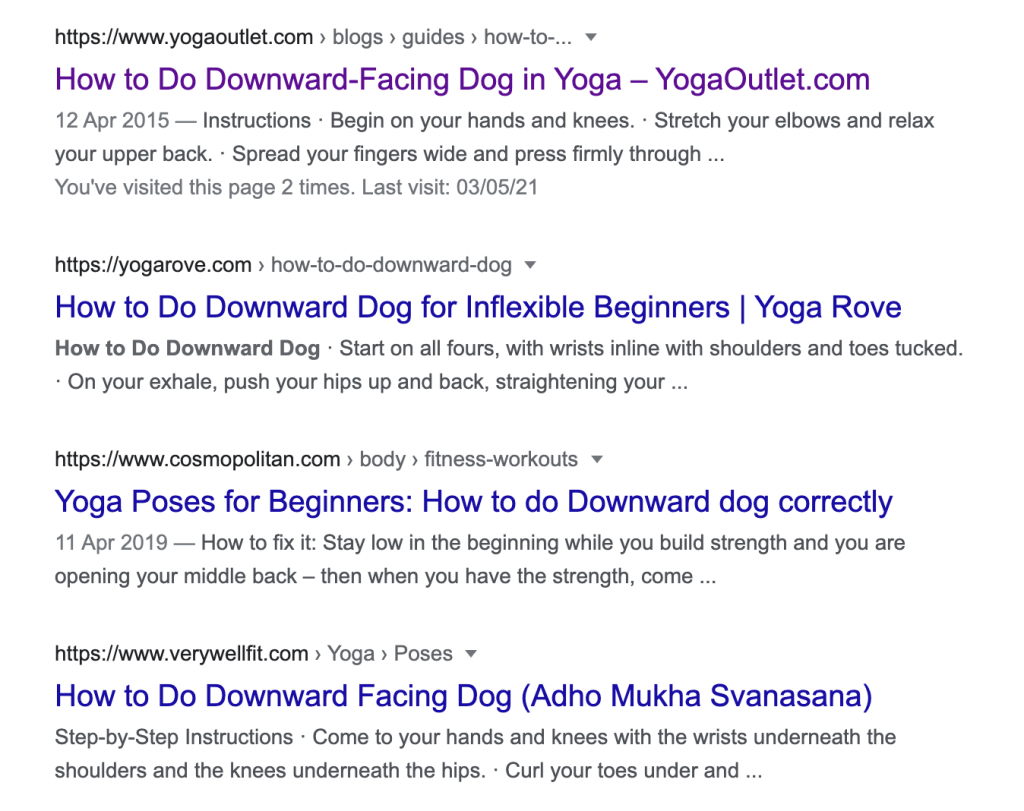In this blog article I want to give a quick and dirty tip to help you know how to structure blog content.
You know the pain. You’ve sat down to write a blog article and you are staring at an empty page.
You know the topic and the keyword from running keyword research. But to go from the keyword to a full blog article seems impossible.
So it’s just you, the blank page and that awful blinking cursor.
How to structure blog content using what already works
Let’s get you out of that rut with a fast and horrendously effective tip.
We’re going to see how the top ranking pages for your keyword already structure their blog content.
We’ll use this information not simply to copy but to go beyond and improve what it is they’ve already done. We’ll leapfrog the current top ranking content.
The basic idea here is to:
- Get the structure of competitor blog content for your keyword and
- Mix up and improve to make something bigger and better
Worked example: Downward Dog
Let’s say I’m a yoga instructor and I sell yoga courses.
I want to attract people to my blog content, show them I know what I’m talking about and sell them my video course.
To do this I regularly write blog articles discussing common yoga questions. I’ve down my SEO keyword research to find out what people search for most often and today I’m writing an article on “how to do downward dog”. It’s a core yoga pose and one that requires mastery before students move onto more advanced poses.

Instead of me just free-associating any old thing about “how to do downward dog” I’m going to be smart.
I first head over to Google and plug “how to do downward dog” into Google.
I get a set of results like this:

Now, I could just check out these pages and take notes to see what my SEO competitors are doing. That’s a step in the right direction but too time consuming. There’s too much content fluff and to work out the blog content structure requires me to pay close attention.
Instead I’m going to get smart and pull the structure straight out of the content.
Removing the structure from the blog content
Here’s where we get smart.
Grab the URL of the top SEO competitor.
Plug it into this site: SEO Review Tools Headline Checker
This tool will go ahead and grab the headers from the page and spit out a result like this:

We are interested in those H2 tags. H2 tags are generally used as the primary “heading” tags within a blog article. H1 is the title of the page itself so of less interest.
Looking at those H2s we can see the full structure of their article laid bare:
- Benefits
- Cautions
- Instructions
- Modifications & Variations
- Tips
- Dog Days of Yoga (a summary)
These are al areas that I can speak to in my article.
We don’t stop here though.
Combine best practices
Instead I’ll go ahead and do this for the top 3-5 SEO competitors to see how they structure their blog content.
Remember, these are the top ranking pages and posts for this keyphrase. If I’m going to copy I may as well copy from the best!
From next page gives me:
- Benefits of Downward Dog
- How to Do Downward Dog
- Warming Up for Downward Dog
- Mistakes People Make During Downward Dog
- Beginner Modifications for Downward Dog
- Alignment Tips to Improve Downward Dog
- Possibile Variations
Another gives me:
- Step by step
- Beginners’ tips for Downward Dog
- Benefits of Downward Dog pose
- Watch out for
- Variations
I’ll do this for as many pages as required for me to get an idea of the best structure. From these three examples alone we can see certain sections that pop up again and again (benefits, how-to/instructions and variations are the most obvious).
These are all headlines that I will therefore include in my article as a bare minimum.
How to structure blog content: going above and beyond
The real power of this methodology however is not simply being a way to emulate and catch up with SEO competitors. More than that we want to use this method to outcompete.
We want to make the best blog article on this topic. An article that is better than all of our competitors.
Based on this I would work towards including all of the header from my 3 competitors above. And maybe even more.
I’d want to flesh out the topic and provide information that was previously on 3 different sites. Now in one place. And that place is my blog!
Following the example above my headers might looks like this:
- Benefits
- Cautions
- How to Do / Instructions
- Warming Up
- Mistakes People
- Beginner Tips
- Beginner Modifications
- Alignment Tips
- Variations
Obviously, if I research even more competitors I’ll be able to come up with more headers and be able to further flesh out my article. Even with the 3 examples above however I’ve got more headers (and thus more potential content) than any of the 3 individually.
Of course, you still need to produce great content! That’s the next required step. But at least you know what content it is you need to write!